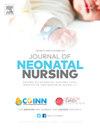将小婴儿从恒温箱移至coT (RABBIT):一项具有比较臂的准实验设计研究
Q2 Nursing
引用次数: 0
摘要
目的评估小新生儿或早产儿在按照预先规定的断奶方案从培养箱断奶至开放式婴儿床后的头7天内是否能保持热稳定性,并与没有预先定义标准的回顾性对照断奶进行比较。方法本准实验研究纳入了出生在<;34周胎龄和出生体重小于1400 g和需要孵化器至少72 h。照顾一个婴儿被认为适合断奶在34周纠正胎龄(或1400克无论妊娠年龄)提供婴儿保持腋窝温度≥36.70摄氏度在36.00摄氏度,一套伺服和孵化器平均空气温度≤270摄氏度至少48小时。转移到床上,一个预先设计流程图被旁边的婴儿,以维持腋窝温度。将前瞻性干预组与回顾性对照组进行比较。结果该研究将63名婴儿纳入干预研究组,与65名回顾性对照组相比。实验组与对照组腋窝温度差异无统计学意义。没有婴儿因无法保持温度而被送回恒温箱。然而,与回顾性对照组相比,干预研究组的婴儿从出生体重到出院和一周后转入婴儿床的体重增加。结论采用标准化方案断奶婴儿体温维持与对照组相似。然而,研究小组的体重增加得更好。本文章由计算机程序翻译,如有差异,请以英文原文为准。
Removing smAll BaBies from incubators to coT (RABBIT): A quasi-experimental design study with comparison arm
Aim
To assess if small or premature neonates can maintain thermal stability during the first seven days, when weaned from incubator to open cots following a pre-specified weaning protocol, compared to a retrospective control weaned without pre-defined criteria.
Methods
This quasi-experimental study included infants born at < 34 weeks gestational age or birthweight less than 1400 g and needing incubator care for at least 72 h. An infant was deemed suitable for weaning at 34 weeks corrected gestational age (or at 1400 g regardless of gestational age) provided the infant maintained an axillary temperature ≥36.70Celsius on a servo-control set at 36.00Celsius, and the incubator air temperature averaged ≤270Celsius for at least 48 h. Upon transferring to the cot, a pre-designed flow chart was placed next to the baby, with a view to maintain axillary temperature. The prospective intervention group was compared with the retrospective control group.
Results
The study enrolled 63 babies in the intervention study group compared with 65 retrospective controls. There was no significant difference in axillary temperature between intervention and control groups. No baby was returned to the incubator due to failure to maintain temperature. However, there was an increased weight gain from birth weight to discharge and post one week transfer into the cot for the intervention study group of babies in comparison to the retrospective control group.
Conclusion
Temperature maintenance in babies weaned using standardised protocol was similar to the control group. However, better weight gain was seen in the study group.
求助全文
通过发布文献求助,成功后即可免费获取论文全文。
去求助
来源期刊

Journal of Neonatal Nursing
Nursing-Pediatrics
CiteScore
2.00
自引率
0.00%
发文量
143
期刊介绍:
Aims & Scope: This is the practical, bimonthly, research-based journal for all professionals concerned with the care of neonates and their families, both in hospital and the community. It aims to support the development of the essential practice, management, education and health promotion skills required by these professionals. The JNN will provide a forum for the exchange of ideas and information between the range of professionals working in this field; promote cooperation between these professionals; facilitate partnership care with families; provide information and informed opinion; promote innovation and change in the care of neonates and their families; and provide an education resource for this important rapidly developing field.
 求助内容:
求助内容: 应助结果提醒方式:
应助结果提醒方式:


